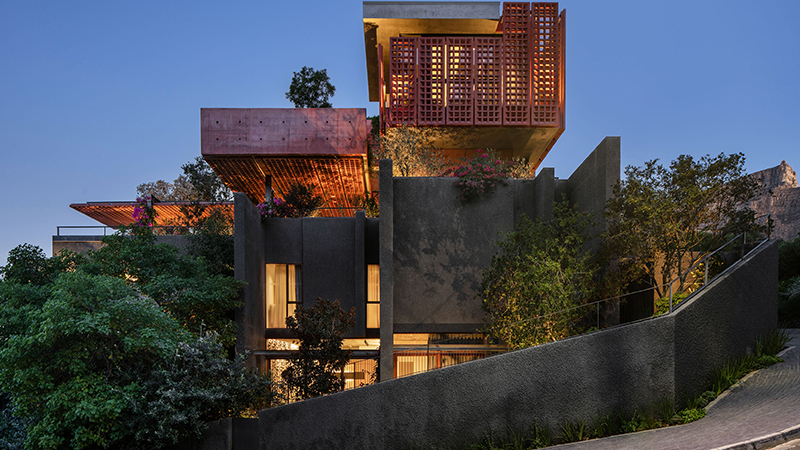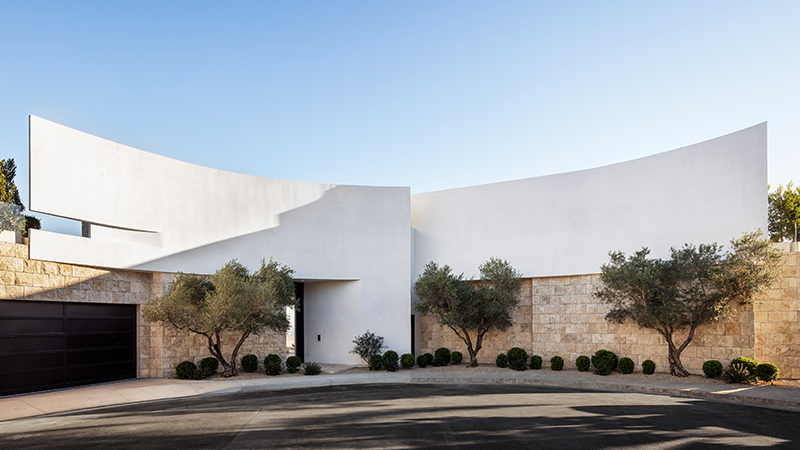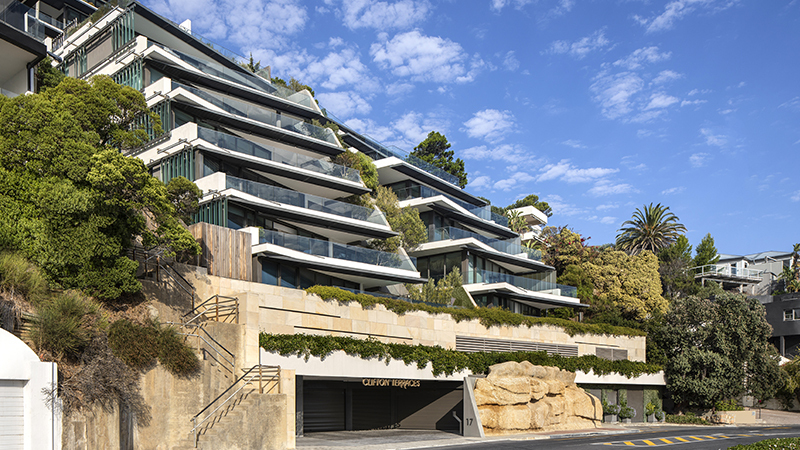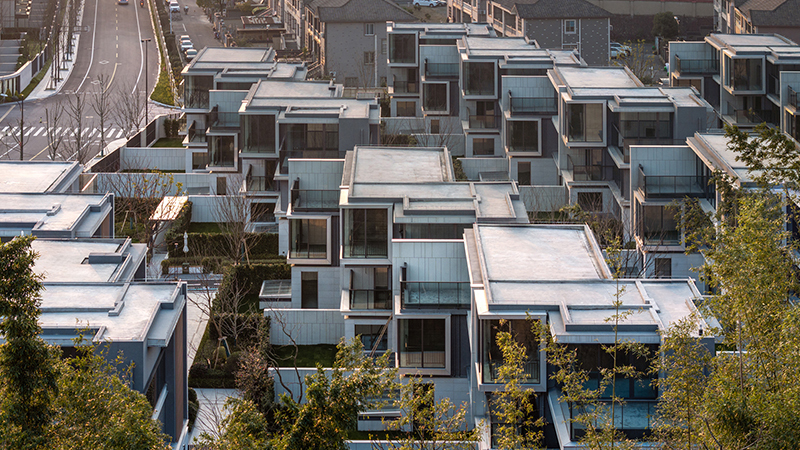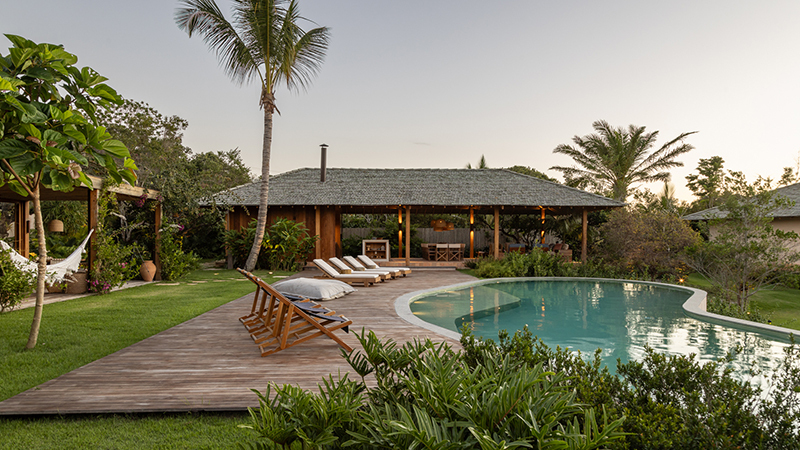位于悉尼市中心附近的一个历史悠久的郊区,周围环绕着树木繁茂的住宅区,其独特的地理位置决定了从居住空间和视野的方向和组织到材料色调和景观美化等每一项设计选择。创造与水的连续界面至关重要,最大化海景,同时保持最佳隐私也很重要。
Located in a historical suburb in a treed residential enclave close to Sydney's central business district, this project's unique position overlooking the harbour guided every design choice, from the orientation and organisation of living spaces and outlooks to the material palette and landscaping. Creating a continuous interface with the water was critical, as was maximising the ocean views, while maintaining optimum privacy.
为创造一处独特的多层家庭住宅,团队需要将三个地块连接在一起。这为团队提供了广阔的场地面积,也提供了很大的创意空间。但同时也带来了各种挑战,其中最关键的之一是将别墅的轮廓尽量降低,以确保不妨碍周围物业的景观,并保持社区独特的适度规模的住宅特色。一种敏感的方法,包括将建筑物降低到地形中并保持充足的退台,导致了从街道上看到的微妙而谦逊的外观,这一角度掩盖了从港口一侧可见的大胆雕刻的石质形态、独特的立面和悬臂式起居区。
The brief to create a distinctive multilevel family home required joining together three erven. This gave the team an expansive footprint to work with and offered a lot of creative scope. It also posed various challenges, one of the most crucial being to minimise the villa’s profile to ensure the surrounding properties' views weren't impeded and that the neighbourhood's unique modestly scaled residential character was preserved. A sensitive approach – which entailed lowering the building into the landscape and maintaining generous setbacks - led to a subtle and modest appearance from the street, a perspective that belies the boldly sculpted stone form, distinctive façade and cantilevered living areas visible from the harbour side.
这座别墅的设计旨在反映其所处的环境,包括附近的郊区和更广阔的悉尼港。SAOTA负责人Philip Olmesdahl利用环境的其宏伟和规模来指导建筑的形状和材料选择。宽阔的海洋地平线的水平特征促使设计沿着场地的线性布置,并延伸的斜切面,这些斜切面可以反映与海岸线的关系,并优化所有区域的视野。熔岩石外墙使建筑物能够立即与周围的景观融为一体,而在外部立面的其余部分使用的温暖材料调色板,磨砂Mount White砂岩(一种典型的土地语言材料)、风化铜和青铜铝,是受到了围绕悉尼港的砂岩悬崖边缘的色调和质地的启发。
The villa was designed to reflect the setting, both the nearby suburb and the broader Sydney Harbour. SAOTA principal Philip Olmesdahl used the context – its grandeur and scale – to guide the shape and materials of the building. The horizontal characteristics of the expansive ocean horizon prompted the design’s linear arrangement along the site and extended chamfered planes, which serve to mirror the relationship with the coastline and optimise the views from all areas. The Lava stone cladding allows the building to blend immediately with the landscape, while the warm material palette used throughout the rest of the exterior façade – Honed Mount White Sandstone (a typical vernacular material), Weathered Copper and Bronze Aluminium – is informed by the tones and textures of the sandstone cliff edges that line Sydney Harbour.
这座别墅的私密性从进入空间的序列逐渐展开 ,翠绿的景观庭院让位于矗立在斜切石柱上的高耸门廊,引导游客进入别墅。一旦进入内部,戏剧性的双层空间由强健的雕刻白砂岩柱子定义,这些柱子支撑着屋顶就像树木支撑着树冠一样,全高度的玻璃幕墙框出了标志性的海港景观。与房屋形式与环境密不可分的方式相同,室内空间最大限度地与环境对话;起居区位于一楼,可以流通户外空间,卧室位于顶层,以获得最佳的景观和隐私。在起居室,石柱的坚固性和空间的宏伟尺度被精美图案和穿孔铜屏幕所抵消,这些屏幕柔和地过滤自然光线,并暗示了周围的树叶。
The discreet and private arrival sequence unfolds gradually – the lushly landscaped forecourt giving way to a soaring porte-cochère resting on chamfered stone columns that guide visitors into the villa. Once inside, dramatic double-volume spaces are defined by muscular carved white sandstone columns that support the roof – like trees supporting a canopy – and full-height glazing that frames the iconic harbour views. In the same way that the form of house is inextricably linked to the setting, the indoor spaces maximise a conversation with the setting; living areas are situated on the ground floor to flow outdoors and bedrooms on the top level for optimal views and privacy. In the living room, the solidity of the stone columns and grand scale of the spaces is countered by delicately patterned and perforated copper screens – which filter natural light softly in and allude to the surrounding foliage.
在整个过程中,通过大型推拉门轻松进入户外生活空间,可以无间断地欣赏海湾的景色。从主别墅下降的室外露台被设计为充分利用景观,并始终避免受到自然元素的影响。
Throughout, outdoor living spaces are accessed easily via large sliding doors that allow for uninterrupted vantage points of the bay. Descending external terraces from the main villa are designed to take maximum advantage of views and always be sheltered from the elements.
正如建筑物体现了环境,景观设计也回应了建筑的大胆。由Myles Baldwin精心设计,景观设计是这个项目的核心。在这里,稀有的澳大利亚本土物种、大型标本和雕塑般的热带植物呼应了场地和建筑的规模,使花园具有适当的氛围。沿着倾泻而下的泳池,您会被引导向港口,并体现了项目对环境的赞美。
As the architecture speaks to the context, so the landscaping echoes the boldness of the architecture. Strikingly executed by Myles Baldwin, the landscaping was central to the project. Here, rare native Australian species, large specimens and sculptural tropical plants echo the scale of the site and the structure, giving the garden a fitting sense of establishment. Pools that cascade down direct you towards the harbour and speak to the project's celebration of the setting.
PROJECT CREDITS
Project Name Water’s Edge
Project Location Sydney, Australia
Lead Designers SAOTA
SAOTA Project Team Philip Olmesdahl, Erin Gibbs, Gerald Southwood &
Jochen Schmidt Von Wuhlisch
Architects in Association TKD Architects
Interior Architects ARRCC
ARRCC Project Team Michele Rhoda, Daniel Du Toit, Jeandre Toua & Leigh Daniels
Interior Designers Geoffrey Lopez, POCO Designs & TKD
Architects
Contractor Pimas Gale
Structural Engineer Patridge
Electrical Engineer Floth
Landscaping Myles Baldwin
Lighting Design Firefly Point of View
Photographer Tom Ferguson
Copy by Julia Freemantle
更新日期:2024-05-31 16:58:18
非常感谢 SAOTA 带来的精彩项目, 查阅更多Appreciations towards SAOTA for sharing wonderful work on hhlloo. Click to see more works!




















